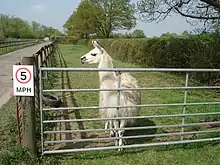Berserk llama syndrome
Berserk llama syndrome (usually shortened to BLS), aberrant behavior syndrome, or berserk male syndrome (as it is more pronounced in males) is a psychological condition suffered by human-raised camelids, particularly llamas and alpacas, that can cause them to exhibit dangerously aggressive behavior toward humans. The term has been overused, however, and is sometimes inappropriately applied to llamas with aggressive personalities that are not truly "berserk".[1][2][3]

Causes
The condition was first observed and documented in the 1970's, upon the importation of llamas to the rural United States.[4]
BLS is a result of overexposure of a juvenile llama, a cria, to humans, which results in the cria imprinting on its human handlers to such a degree that it considers them to be fellow llamas.[5] Imprinting can be caused by bottle feeding, which is utilized due to a cria rejecting its mother's milk or when there is insufficient maternal milk supply. Another contributing factor is isolation from other llamas.[1] When the cria reaches maturity, the llama can not distinguish humans from other llamas and may try to demonstrate their dominance. Adult male inter-llama interaction can be rough, including chest-ramming, charging, leg-wrestling, and biting, and they are strongly territorial. In some severe cases, llamas suffering from BLS may sneak up to their owners and attack them from behind.[6] Male llamas suffering from this condition become dangerous when this behavior is directed toward humans and they usually have to be euthanised. Female llamas can also suffer from berserk llama syndrome but their behavior is usually limited to spitting and difficult handling.[5]
Prevention and treatment
In males, the chance of developing berserk llama syndrome can be reduced through castration before puberty.[7] However, BLS can still appear in gelded males.[8] A majority of berserk males are euthanized.[9][10]
References
- "Berserk Male Syndrome". Llamapaedia.com (via the Internet Archive). 1997-09-21. Archived from the original on 2007-06-29. Retrieved 2007-06-29.
- "Problematic behavior in llamas and misdirected territorial aggression". Lost Creek Llamas. Archived from the original on 2007-11-01. Retrieved 2007-10-16.
- "John Mallon - Gentling & Training Llamas & Alpacas (Aberrant Behavior Syndrome)". www.johnmallonclinics.net. Retrieved 2020-06-21.
- "Berserk Llama Syndrome". 2007-10-30. Retrieved 2020-06-21.
- "20 What is Berserk Male Syndrome?". Stason.org. 2007-09-11. Retrieved 2007-10-16.
- "Daily Curio #980: Berserk llama syndrome". Curious.com. Retrieved 2020-06-21.
- "Berserk llama attacks woman in Central Oregon". Associated Press. 2007-09-13. Archived from the original on 2007-10-31. Retrieved 2007-10-16.
- https://lib.dr.iastate.edu/cgi/viewcontent.cgi?article=2116&context=ans_air
- Kitch, Justin; Homestead, ContributorCo-founder of; Curious.com; blog, author of The Daily Curio; Learning, Lover of Lifelong (2016-04-01). "From Berserk Llama Syndrome to Acoustic Pest Detection: This Week's Curios". HuffPost. Retrieved 2020-06-21.
- https://lib.dr.iastate.edu/cgi/viewcontent.cgi?article=2116&context=ans_air